Excursions Live!
Fourth Hour Exam
December 6, 2000
![]()
![]()
Statistics:High:Mean:
Low:
For every question, also consider as a possible answer
E) none of the above
Possibly useful information:
v = x / t ![]() p = m v
p = m v![]() T = 2 ¹
T = 2 ¹![]()
a = v / t ![]() PEg
= m g h
PEg
= m g h ![]() T = 2 ¹
T = 2 ¹ ![]()
v = vi + a t ![]() PEspg
= (1/2) k x2
PEspg
= (1/2) k x2 ![]() v
=
v
= ![]()
x = xi + vi t + (1/2) a t2
![]() KE = (1/2)
m v2
KE = (1/2)
m v2
y = yi + vyi t + (1/2) ay
t2 ![]() F = k x
F = k x ![]() v
= (wavelength) x (frequency)
v
= (wavelength) x (frequency)
v = r ![]()
![]() E
= KE + PE
E
= KE + PE ![]() L = (n) x (half
wavelength)
L = (n) x (half
wavelength)
F = m a ![]() Ei
= Ef
Ei
= Ef ![]() c = 3.00
x 108 m/s
c = 3.00
x 108 m/s
F12 = - F21 ![]() pi
= pf
pi
= pf ![]() n = v
/ c
n = v
/ c
w = mg ![]() Fc = m
v2 / r
Fc = m
v2 / r ![]() 1/f
= 1/di + 1/do
1/f
= 1/di + 1/do
g = 9.8 m/s2 Å 10 m/s2 ![]() F
=
F
= ![]() p /
p / ![]() t
t
![]() di
= [1/n] do
di
= [1/n] do
M = &endash; di/do
M = (25 cm)/f
M = fobj / feye
E) none of the above
1. Light
A) is a longitudinal wave (light is a transverse wave).
B) is a mechanical wave (requires a medium to travel through) (light is an EM wave).
C) has a wavelength between 200 nm and 400 nm (light has a wavelength between 400 and 700 nm).
D) all of the aboveE) none of the above
2. Light
A) is an electromagnetic wave.
B) is a longitudinal wave. (light is a transverse wave).
C) has a wavelength between 800 nm and 900 nm (light has a wavelength between 400 and 700 nm).
D) all of the above
3. The speed of light
A) was too fast for Galileo to measure
B) was not accurately measured or explained by Newton
C) was very accurately measured by A A Michelson
D) all of the above
4. The speed of light
A) was too slow for Galileo to measure
B) was measured by Ole Romer using astronomical data
C) was measured by A A Michelson using biological data (by Michelson, but not with bio data)
D) all of the above
5. Compared to ultraviolet waves, the wavelength of infrared is
A) longerUV has wavelengths less than 400 nmIR has wavelengths greater than 700 nm
B) identical
C) shorter
6. Compared to radio waves, the velocity of visible light waves in a vacuum is
A) greater
B) the same (all EMwaves have the same speed, c = 3 x 108 m/s)
C) less
7. Compared to radio waves, the wavelength of visible light waves in a vacuum is
A) longer
B) the same
C) shorter
8. Which of the following is fundamentally different from the others?
A) X-rays
B) visible light waves
C) sound waves (Soundis a longitudinal, mechanical wave.The rest are all transverse, EMwaves).D) radio waves
9. Electromagnetic waves consist of
A) compressions and rarefactions of electromagnetic pulses.
B) oscillating electric and magnetic fields.
C) particles of light energy.
D) high-frequency gravitational waves.
10. Electromagnetic waves
A) can travel through a vacuum. (Simply consider the example of sunlight!)
B) need a medium to travel through.
11. The main difference between a radio wave and a light wave is its
A) speed
B) wavelength
C) EM characteristic
D) all of the above
12. Which of these electromagnetic waves has the shortest wavelength?
A) X-rays
B) ultraviolet waves
C) infrared waves
D) radio waves
13. The sensation of color is seen when light falls on the eye's
A) rods
B) cones
C) cornea
D) ciliary lens
14. A spotlight produces white light which then passes through a filter that absorbs the yellow light. What color is the light that passes through?
A) red
B) green
C) blue
D) yellow
15. When you see a rainbow, you see
A) red on the inside and violet on the outside
B) yellow on the outside and green on the inside
C) yellow on the inside and green on the outside
D) violet on the inside and red on the outside
16. The colored dots that make up the color on a TV screen are
A) red, yellow, green
B) red, yellow, blue
C) red, green, blue
D) cyan, magenta, yellow
17. Colors seen on TV result from color
A) subtraction
B) addition
C) neither of these
D) either of these
18. Colors seen in paint result from color
A) subtraction
B) addition
C) neither of these
D) either of these
19. Look at a full-color picture in a magazine with a magnifying glass and you will see that the inks used are
A) red, green, cyan, and blue.
B) red, green, blue, and black.
C) cyan, magenta, yellow, and black. (CYMK)
D) cyan, green, yellow, and blue.
20. A mixture of red and blue light produces
A) blue
B) magenta
C) yellow
D) cyan
21. A sheet of blue paper will look black when illuminated with
A) red light
B) cyan light
C) blue light
D) magenta light
22. As light passes from glass into air, it is bent
A) toward the perpendicular
B) away from the perpendicular
23. Refraction causes the bottom of a swimming pool to appear
A) farther away than it really is
B) closer to the surface than it really is
24. Different colors are dispersed by a prism because different
colors in the spectrum have different
A) angular momenta
B) speeds
C) energies
D) momenta
25. The critical angle for a transparent material is the angle at and beyond which all light within the material is totally
A) absorbed
B) reflected
C) refracted
D) polarized
26. Light will not pass through a pair of Polaroid filters when their axes are
A) parallel (Maximum light passes in this orientation).
B) rotated 45°
C) rotated 57°
D) perpendicular
27. Consider two Polaroid filters, A and B, rotated 90° with respect to each other as sketched here:

Now place another Polaroid filter C, between these
two, as sketched here:
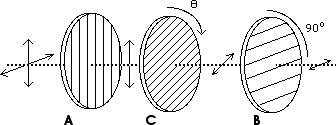
As Polaroid filter C is rotated through a full 360°, the light coming through this combination of filters goes from bright to dark how many times?
A) none; it remains dark.
B) two times.
C) four times (every rotation of 90 degrees)
D) eight times
28. Your vision is sharpest when your pupil is
a) dilated or opened wide
b) constricted or made tiny
c) blue
d) brown
29. Rainbows are a result of
A) dispersion and reflection.
B) dispersion and polarization.
C) reconstruction and polarization.
D) constructive and destructive interference.
30. A single rainbow requires
A) only one reflection inside the raindrops.
B) two reflections inside the raindrops.
C) constructive interference inside the raindrops.
D) destructive interference inside the raindrops.
31. A double rainbow is a result of
A) one refraction and two reflections.
B) one dispersion and two polarizations.
C) two reconstructions and one polarization.
D) two refractions and two reflections.
32. A 2-m tall person viewing his full-length image in a plane mirror
requires a mirror that is at least
A) 0.25 m
B) 0.50 m
C) 1.0 m
D) 2.0 m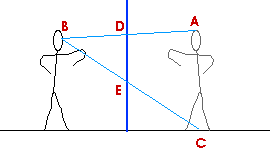
33. An object is placed 60 cm from a converging lens that has a focal
length of 20 cm. Make a ray diagram of this situation. From
the ray diagram, characterize the image.


The image is
A) real, inverted, and larger.
B) real, inverted, and smaller.
C) virtual, upright, and smaller.
D) virtual, inverted, and smaller.
34. An object is placed 40 cm from a converging lens that has a focal length of 20 cm. Make a ray diagram of this situation. From the ray diagram, characterize the image.
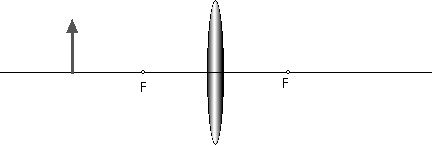
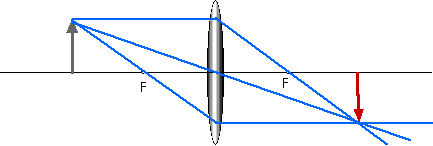
The image is
A) real and inverted (and the same size)
B) virtual, inverted, and smaller.
C) virtual, upright, and smaller.
D) virtual, inverted, and larger.
35. An object is placed 30 cm from a converging lens that has a focal length of 20 cm. Make a ray diagram of this situation. From the ray diagram, characterize the image.

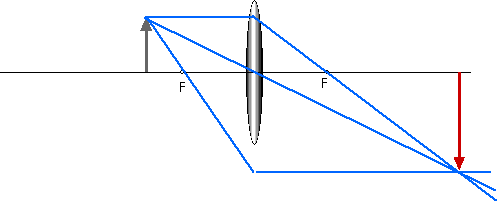
The image is
A) real, inverted, and larger.
B) real, inverted, and smaller.
C) real, upright, and smaller.
D) virtual, upright, and larger.
36. An object is placed 10 cm from a converging lens that has a focal length of 20 cm. Make a ray diagram of this situation. From the ray diagram, characterize the image.


The image is
A) real, inverted, and larger.
B) real, inverted, and smaller.
C) virtual, upright, and smaller.
D) virtual, upright, and larger.
37. The “near point” of a person’s eye is
A) 25 cm
B) the farthest distance at which that person can clearly see an object
C) the nearest distance at which that person can clearly see an object
D) infinitly far away
38. The type of lenses needed to correct nearsighted vision
is

A) converging
B) diverging
C) convex
D) concave
39. The type of lenses needed to correct farsighted vision
is

A) converging
B) diverging
C) convex
D) concave
40. Initially, a camera is focused on some far-distant mountains. It
is then adjusted to focus on a nearby person . To do this, the
lens
a) is moved closer to the film.
b) is moved farther from the film.
c) is "opened" to larger aperature or larger opening.
d) is "shut down" to a smaller aperature or smaller opening.1/f = 1 /di + 1 /doAs you make do, the object distance, smaller, you must make di, the image distance, larger.
41. A simple magnifier produces
A) a virtual image between the lens and your eye
B) a real image between the lens and your eye
C) a virtual image beyond the near point of your eye
D) a real image at infinity
42. In an optical system with two lenses,
A) the size of the final image is the magnification of the first lens multiplied by the object
distance of the second lens
B) the magnification of the whole system is the sum of the magnifications of the two lenses
C) the image produced by the first lens is always virtualD) the image produced by the first lens can be treated as an object for the second lens
43. A microscope uses the front lens or objective lens to produce
a
A) virtual image which is right side up.
B) virtual image at infinity.
C) real image which is then viewed through the eyepiece.
D) real image which is right side up.
44. A telescope uses the front lens or objective lens to produce a
A) virtual image which is right side up.
B) virtual image at infinity.
C) real image which is then viewed through the eyepiece.
D) real image which is right side up.
45. A telescope that uses lenses is subject to
A) chromatic abberration.
B) spherical abberration.
C) aspherical abberration.
D) birefringence.
46. A Newtonian telescope is a
A) refracting telescope.
B) polarizing telescope.
C) reflecting telescope.
D) diffracting telescope.
47. We see interference effects if a laser is shined at or through a
double slit (this is Young’s double slit experiment). We do
not see interference effects due to the light coming from two
flashlights because their light is
A) coherent.
B) incoherent.
C) too dim.
D) too bright.
48. Light from a laser is
A) monochromatic
B) in phase
C) coherent
D) all of the above
49. In the interference pattern produced by shining a laser through
two slits (Young's double slit experiment), the dark areas are
the result of
A) destructive interference.
B) polarization.
C) constructive interference.
D) restructive construction.
50. When you view a white light source through a diffraction grating
you will see brightly colored spectrum with
A) yellow on the outside and green on the inside
B) yellow on the inside and green on the outside
C) violet on the inside and red on the outside
D) red on the inside and violet on the outside
![]()
| Return to PHY3050 Calendar |
![]()
PHY 3050G -- Fourth Hour Exam, 12/6/2000
(C) 2003, Doug Davis; all rights reserved